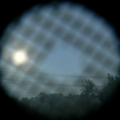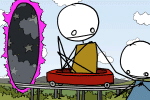#287821 - 01/13/18 04:55 AM
 USCG Strobe lab & field test reports - 2012 & 2015
USCG Strobe lab & field test reports - 2012 & 2015
|

Enthusiast

Registered: 11/29/09
Posts: 265
Loc: Southern California
|
I spotted two 80ish page USCG test reports on strobe effectiveness tonight. I only skimmed them, but thought they looked interesting. Links and abstracts below. Suitability of Potential Alternatives to Pyrotechnic Distress Signals (2012) Abstract : Purpose: To determine the potential suitability of electronic alternatives to pyrotechnic visual distress signals through the evaluation of the effectiveness of presently-available LED (and other) devices as visual distress signal devices (VDSDs). Methods: Requirements workshop, market research, field testing to assess visibility at different ranges, paired comparison testing to assess attention-getting characteristics, and ergonomic testing. Results: Lab test results predicting device visual detection range based on effective intensity compared well with results obtained from field testing. Light-emitting diode (LED) devices tested consistently better than incandescent or flashtube devices. Color and flash pattern (rapid flash rate or S-O-S characteristic) improved the perceptive performance of the devices. Conclusions: LED devices have potential as an alternative to pyrotechnic VDSDs. Desirable VDSD characteristics identified in this report can be used to inform future VDSD performance requirements development. Intensity profiles (omni-directional versus narrow beam) must be considered when comparing predicted visual detection ranges. Detection ranges predicted from laboratory-measured Effective Intensity of white VDSDs compared favorably with ranges observed during field tests. This indicates that Effective Intensity can be used in lieu of field tests to predict the visual detection range of VDSDs under specified meteorological conditions. Alternatives to Pyrotechnic Distress Signals; Laboratory and Field Studies (2015) Abstract : This report documents a multi-year project effort to develop a specification for a light-emitting diode (LED) signal characteristic as an alternative to pyrotechnic, maritime distress signal flares as visual distress signals. The report includes the methodology used in evaluating color, flash pattern, and intensity for an LED distress signal, conspicuous against certain lighting conditions, at six nautical miles, in 10 miles meteorological visibility. The effort included a literature review, measurement and quantifying different levels of background lighting to recreate their effect in a vision laboratory, a series of laboratory tests to determine signal conspicuity in a controlled environment, and a field test in the marine environment. The human-subject laboratory experiments determined relative LED signal conspicuity, based on subjects' accurate identification of a signal and the response time to make that identification. The lab results (conspicuous signal characteristics) were the basis for field testing. In addition to LED signals, the human-subject field test included two, commercial, off-the-shelf (COTS) signal devices and a handheld pyrotechnic flare in the signal evaluation. In four nights of testing, the experimenters produced a signal characteristic that was significantly more conspicuous than the flare and the two COTS devices.
|
|
Top
|
|
|
|
#287822 - 01/13/18 08:24 AM
 Re: USCG Strobe lab & field test reports - 2012 & 2015
[Re: rafowell]
Re: USCG Strobe lab & field test reports - 2012 & 2015
[Re: rafowell]
|

Carpal Tunnel

Registered: 04/28/10
Posts: 3187
Loc: Big Sky Country
|
Interesting! I have been contemplating adding a strobe to my land based gear. Obviously the USCG is looking for folks over water but it seems that if one is lost and an air search is being conducted a beacon may be helpful.
_________________________
“I'd rather have questions that cannot be answered than answers that can't be questioned.” —Richard Feynman
|
|
Top
|
|
|
|
#287826 - 01/13/18 02:21 PM
 Re: USCG Strobe lab & field test reports - 2012 & 2015
[Re: Phaedrus]
Re: USCG Strobe lab & field test reports - 2012 & 2015
[Re: Phaedrus]
|

Geezer in Chief
Geezer
Registered: 08/26/06
Posts: 7705
Loc: southern Cal
|
On page 55 of the report, these interesting obserations: "The R&DC project team believes that it is well within reach (considering current off the shelf and
developmental devices) to manufacture a signal device as described. As a matter of example, this report
includes an Appendix C that discusses battery requirements for an LED Visual Distress Signal Device.
The characteristic for the “electric S-O-S distress light” defined in 46 CFR 161.013 is inadequate. During
laboratory pilot testing, the project team almost immediately realized the shortcomings associated with
prolonged eclipses (“off time”) between letters and SOSs. The project team performed multiple iterations on
the SOS signal before achieving a flash pattern that achieved a reasonable level of conspicuity. "
It is almost impossible to buy a flashlight that does not have some sort of 'flash,' 'strobe", or "beacon" function. Some evaluation of these products would be useful. Most that I have seen are monochromatic - white. They are probably way better than nothing, but probably not as effective as the goold old signal mirror...
_________________________
Geezer in Chief
|
|
Top
|
|
|
|
#287837 - 01/14/18 02:44 PM
 Re: USCG Strobe lab & field test reports - 2012 & 2015
[Re: hikermor]
Re: USCG Strobe lab & field test reports - 2012 & 2015
[Re: hikermor]
|

"Be Prepared"
Pooh-Bah
Registered: 06/26/04
Posts: 2212
Loc: NE Wisconsin
|
It is almost impossible to buy a flashlight that does not have some sort of 'flash,' 'strobe", or "beacon" function. Some evaluation of these products would be useful. Most that I have seen are monochromatic - white. They are probably way better than nothing, but probably not as effective as the goold old signal mirror... It would seem that there are daytime (daylight) signals and nighttime signals (dark). In general, the daytime signals simply won't work well in nighttime, and vice versa. Signal mirrors and "large" brightly colored objects would fall in the daytime signal group. I like the passive nature of brightly colored objects, but the "large" requirement makes them more difficult to carry than a quality signal mirror. The signal mirror requires some knowledge & experience for effective use. Strobes, flashing flashlights (headlamps), and laser signals would fall in the nighttime signal group. I like the non-directional character of the strobe - in comparison to the directional character of most flashing flashlights and laser signals, but the strobe doesn't have the multi-use feature of a flashlight. I've never been fully comfortable with the laser signalling devices (I have one), but in years past Doug Ritter has spoken well of them. Has anyone else here done some personal testing of laser signals? In the end I tend to think folks need to carry BOTH daytime and nighttime signals even if carrying a personal locator beacon (PLB) in order to facilitate getting found.
|
|
Top
|
|
|
|
#287839 - 01/14/18 03:24 PM
 Re: USCG Strobe lab & field test reports - 2012 & 2015
[Re: rafowell]
Re: USCG Strobe lab & field test reports - 2012 & 2015
[Re: rafowell]
|

Veteran
Registered: 10/14/08
Posts: 1517
|
To carry on with Ken's post, what is important is to be seen, day or night. The colors of your clothing and equipment can help. Large signals can be made on the ground with your colorful gear. If using natural materials think color, contrast and shadow. You can construct signals using things that stand out from the area where you are making your signal. Letters in the sand will work if the provide enough of a shadow. Dig and pile up the sand to construct your signal. Size does matter here. If you are carrying some camping gear or survival gear, choose the things that can be used for signals. Emergency blankets pack small and expand to a fairly large size, more than one is even better. Sleeping bags, tents, sleeping pads, etc., can all be placed end to end to build a large signal. For the strobe, I tend to use the military issue Military Distress Marker . Remove the IR cover and it works well, is light and small. The ACR PLB that I have includes a strobe light when activated.
|
|
Top
|
|
|
|
#287841 - 01/14/18 03:58 PM
 Re: USCG Strobe lab & field test reports - 2012 & 2015
[Re: gonewiththewind]
Re: USCG Strobe lab & field test reports - 2012 & 2015
[Re: gonewiththewind]
|

Geezer
Registered: 06/02/06
Posts: 5359
Loc: SOCAL
|
I went with the ACR Firefly Pro SOLAS - similar. That’s for nighttime along with a 2xCR123R multi-mode LED flashlight. For daytime, signal mirror. My concern was primarily to allow a helo to find a life-raft quickly/efficiently in the middle of a lot of water. THE PLB will get them close...
Edited by Russ (01/15/18 04:49 AM)
Edit Reason: Fixed link
|
|
Top
|
|
|
|
#287843 - 01/14/18 04:46 PM
 Re: USCG Strobe lab & field test reports - 2012 & 2015
[Re: Russ]
Re: USCG Strobe lab & field test reports - 2012 & 2015
[Re: Russ]
|

Geezer in Chief
Geezer
Registered: 08/26/06
Posts: 7705
Loc: southern Cal
|
The ACR Firefly is definitely good. I used an earlier version, the 4f, to pinpoint locations at night on several occasions for helos. Worked like a charm, as do signal mirrors, even in untrained hands.
Our SAR group found, as the result of a series of controlled tests, that an individual on the ground increased the chances of detection considerably by moving - jumping up and down, waving hands, and the like.
I would surmise that the strobe function of an EDC light would be useful - better than nothing at all, but not as obvious as a Firefly...
_________________________
Geezer in Chief
|
|
Top
|
|
|
|
#287858 - 01/15/18 03:13 AM
 Re: USCG Strobe lab & field test reports - 2012 & 2015
[Re: rafowell]
Re: USCG Strobe lab & field test reports - 2012 & 2015
[Re: rafowell]
|

Veteran
Registered: 10/14/08
Posts: 1517
|
I had tried some non-pro strobes on the civilian market, and they did not last. Just from being carried around I had many failures when conducting periodic checks. I just ordered the ACR Firefly Pro Solas, so we will see how durable it is. Thanks for that.
It is getting difficult to find the military ones!
|
|
Top
|
|
|
|
#287860 - 01/15/18 04:54 AM
 Re: USCG Strobe lab & field test reports - 2012 & 2015
[Re: gonewiththewind]
Re: USCG Strobe lab & field test reports - 2012 & 2015
[Re: gonewiththewind]
|

Geezer
Registered: 06/02/06
Posts: 5359
Loc: SOCAL
|
I think you’ll like the ACR Firefly PRO. I fixed the link in the previous post; somehow Amazon snuck in there. Here it is again. ACR ARTEX Firefly PRO Strobe Light The casing is supposedly military spec so I “assume” similar construction to the Mil-Spec unit you had.
|
|
Top
|
|
|
|
#287869 - 01/15/18 10:25 PM
 Re: USCG Strobe lab & field test reports - 2012 & 2015
[Re: rafowell]
Re: USCG Strobe lab & field test reports - 2012 & 2015
[Re: rafowell]
|

Carpal Tunnel
Registered: 03/11/05
Posts: 2574
|
yes; PLB only gets them close..they still have to find you in that last 5,000/500/50 feet
|
|
Top
|
|
|
|
|
|
|
1
|
2
|
3
|
4
|
5
|
6
|
|
7
|
8
|
9
|
10
|
11
|
12
|
13
|
|
14
|
15
|
16
|
17
|
18
|
19
|
20
|
|
21
|
22
|
23
|
24
|
25
|
26
|
27
|
|
28
|
29
|
30
|
31
|
|
|
|
|
|
1 registered (chaosmagnet),
919
Guests and
402
Spiders online. |
|
Key:
Admin,
Global Mod,
Mod
|
|
|